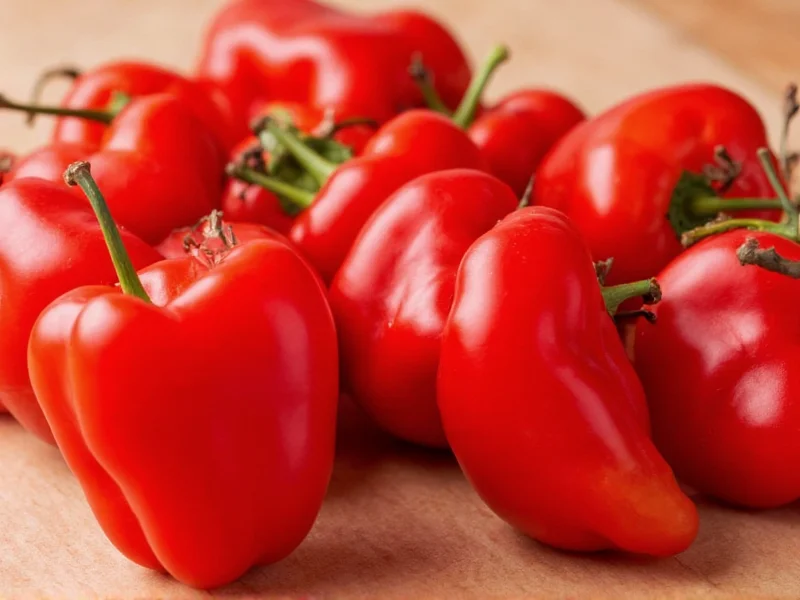Red bell peppers aren't just colorful additions to your plate—they're nutritional powerhouses with minimal caloric impact. Understanding the exact calorie content helps you make informed dietary choices while enjoying this versatile vegetable.
Nutritional Profile of Red Bell Peppers
Red bell peppers rank among the lowest-calorie vegetables you can incorporate into your diet. Their calorie count remains remarkably consistent across different preparation methods, though minor variations occur based on cooking techniques and serving sizes.
| Serving Size | Calories | Carbohydrates (g) | Protein (g) | Fat (g) |
|---|---|---|---|---|
| 1 medium pepper (119g) | 37 | 9.0 | 1.5 | 0.3 |
| 1 cup sliced (150g) | 46 | 11.3 | 1.9 | 0.4 |
| 100 grams | 31 | 7.5 | 1.0 | 0.2 |
| 1 roasted pepper (119g) | 40 | 9.8 | 1.6 | 0.3 |
Why Red Peppers Are Nutritionally Superior
Red bell peppers actually start as green peppers and ripen to red on the vine. This extended ripening period significantly boosts their nutritional value compared to green varieties. While green peppers contain about 30 calories per medium pepper, red peppers provide more vitamins and antioxidants despite having slightly more calories.
The additional calories in red peppers come primarily from increased natural sugars that develop during ripening. However, this small increase brings substantial nutritional benefits:
- Red peppers contain nearly 11 times more beta-carotene than green peppers
- They provide 1.5 times more vitamin C than oranges by weight
- Red peppers contain higher levels of lycopene, a powerful antioxidant
- They offer more vitamin A in the form of beta-carotene
Calorie Comparison Across Pepper Varieties
Understanding how red peppers compare to other common pepper varieties helps contextualize their calorie content:
| Pepper Type | Calories (Medium Pepper) | Key Nutritional Differences |
|---|---|---|
| Red Bell Pepper | 37 | Highest in beta-carotene, vitamin C, and lycopene |
| Yellow Bell Pepper | 34 | High in vitamin C and carotenoids, slightly fewer calories than red |
| Green Bell Pepper | 30 | Lowest in calories but also lowest in antioxidants |
| Jalapeño Pepper | 4 | Very low calorie, contains capsaicin for metabolism boost |
| Habanero Pepper | 2 | Negligible calories, extremely high in capsaicin |
Health Benefits Beyond Calorie Count
While the low-calorie nature of red bell peppers makes them ideal for weight management, their true value lies in their exceptional nutrient density. These vibrant vegetables deliver impressive health benefits with minimal caloric cost:
Red bell peppers serve as one of the richest dietary sources of vitamin C, providing 169% of your daily recommended intake in just one medium pepper. They also contain significant amounts of vitamin A (93% DV), vitamin B6 (19% DV), and vitamin E (13% DV). The combination of these nutrients supports immune function, skin health, and eye protection.
Their high water content (92%) contributes to hydration while providing dietary fiber (2.5g per medium pepper) that aids digestion and promotes satiety. This fiber content makes red peppers particularly valuable for those tracking calories in red pepper recipes while maintaining feelings of fullness.
Practical Applications for Calorie-Conscious Eating
Incorporating red peppers into your diet offers creative ways to reduce overall calorie intake without sacrificing flavor or nutrition. When considering calories in stuffed red pepper dishes, you can maintain the low-calorie advantage by choosing smart fillings like lean proteins and whole grains rather than high-fat ingredients.
For meal preppers tracking calories in roasted red pepper preparations, note that roasting concentrates flavors without significantly increasing calorie content—just 3 additional calories per medium pepper compared to raw. This makes roasted red peppers an excellent addition to Mediterranean diets and other heart-healthy eating patterns.
When following recipes that call for red peppers, remember that the exact calories in red bell pepper can vary slightly based on growing conditions and ripeness, but the differences remain negligible for dietary tracking purposes.
Common Misconceptions About Pepper Calories
Several myths persist about the calorie content of red peppers. Some believe that cooking significantly increases their calorie count, but the reality is that preparation methods like roasting, grilling, or sautéing add minimal calories unless oils or sauces are used.
Another misconception suggests that sweeter red peppers must contain substantially more sugar and therefore more calories than green peppers. While red peppers do contain slightly more natural sugars (4.2g vs 2.9g per medium pepper), this translates to only about 5 additional calories.
Understanding the actual calories in raw red bell pepper versus cooked versions helps dispel these myths and allows for more accurate dietary planning. The nutritional advantages of fully ripened red peppers far outweigh the negligible increase in calories compared to less ripe varieties.
Maximizing Nutritional Value While Tracking Calories
To get the most nutritional benefit from red peppers while monitoring your calorie intake, consider these evidence-based strategies:
- Eat red peppers raw when possible to preserve maximum vitamin C content
- Pair with healthy fats like olive oil to enhance absorption of fat-soluble vitamins
- Store properly in the refrigerator crisper drawer to maintain nutrient density
- Use as a colorful replacement for higher-calorie ingredients in dishes
- Include in salads, stir-fries, and omelets for volume eating with minimal calories
For those specifically tracking calories in red pepper recipes, remember that the vegetable's natural sweetness often allows for reduced sugar in dishes, creating additional calorie savings. Their vibrant color also enhances visual appeal, making meals more satisfying without adding calories.











 浙公网安备
33010002000092号
浙公网安备
33010002000092号 浙B2-20120091-4
浙B2-20120091-4